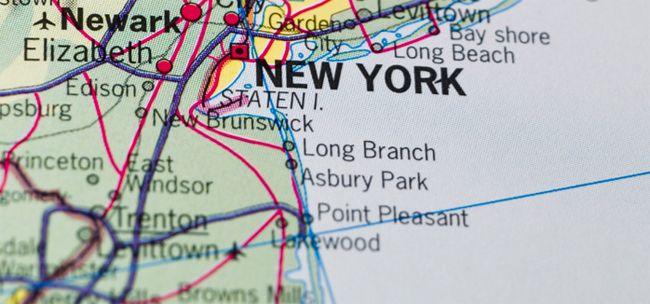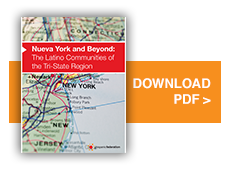Nueva York and Beyond: The Latino Communities of the Tri-State Area

Latinos are changing the New York Region.1 Their influence is being felt in politics, culture and the economy. They are transforming neighborhoods, altering political campaigns, and changing the way businesses do business. Hispanic Federation has not only watched the Hispanic community’s growth and development in the New York Region, it has been a leader in explaining the “how” and “why” of this movement. For this reason we are delighted to present this report on some of the key factors driving the Latinization of the New York Region.
Thanks to our collaborators at Nielsen we have been able to create a unique snapshot of the area’s Latino communities. This report was developed using current data on demographics and consumer behaviors in order to shed light on the burgeoning strength of Latinos and their unique position in the consumer landscape. Because the data is so rich and the insights so penetrating, we believe we have created a document that captures the complexity and diversity of the New York Region’s Latinos in a way that few others have.
Why does this data matter? The truth is that despite increased interest and research about the Latino community, we have often remained tied to ideas that often fail to reflect the nuances of the Latino experience in the region. This reluctance to see variety and difference in our neighborhoods has profound effects on everything from the way we craft policy to the way we do business. As one of the New York region’s leading voices on Latino issues, Hispanic Federation is pleased to offer a document which moves away from received wisdom and offers new ways of understanding what it means to be Latino in the New York Region.
We believe and hope that the data contained in this report will help our partners in philanthropy, business, government and the media to better understand this dynamic sector of our region’s population. As the community continues to grow, understanding its contours and unique qualities becomes essential. Nueva York and Beyond: The Latino Communities of the Tri-State Region is the first step in developing broad awareness of a community that will, in many ways, define the future of the area.
Key Findings
- While Puerto Ricans are still the largest Latino group at 31%, two in five Latinos in the Tri-State are either Dominican, Mexican or Ecuadorian.
- The most rapid growth of Latinos is taking place in those communities where few Latinos have traditionally settled, such as Rockland and Fairfield Counties.
- Seven out of every ten Latinos in the region, 5 million in total, live in just ten counties in NY, NJ and CT.
- Nearly one third of young Latinos living in urban areas are high or middle income earners.
- Latinos are moving up the educational ladder – nearly 1.2 million have at least some college education and nearly one million reported being high school graduates.
- Nearly 60% of all Latinos in the region say they speak English very well or well.
- Latinos account for $92 billion in household income in the New York Region.
- Latinos across the region have high rates of cell phone/wireless usage.
- The share of Latino adults who report shopping online increased 14% (to 74%) from 2009 to 2012.
- More than three out of every four Latino households in NYC metro area pay for cable/satellite TV service.
- For Latinos, reality TV is popular whether you are young or older, urban or suburban, more or less affluent.
- Younger, lower-income Latinos in urban and dense suburbs report radio as the prime source of entertainment.
Section 1: ¿Dónde Estamos? ¿Quiénes Somos?
The US Hispanic Population
From California to New York, and everywhere in between, the United States is experiencing a fundamental realignment of its population. The nation is becoming more diverse with more people whose ancestry winds back to Asia, Africa and the Americas now calling the United States home. In many ways, it is the component parts of the Latino communities of the United States that are most contributing to the dynamic diversification of the U.S. The United States is now home to nearly 55 million Latinos accounting for over 17% of the nation’s total population of 315 million, and their numbers are growing. By 2060, there will be nearly 130 million Latinos in the United States, accounting for over 30% of the total U.S. population.

Where Does the New York Region Fit Within the U.S. Hispanic Population?
New York State has the fourth largest Hispanic population in the United States. With its 3.6 million Hispanic residents, representing 6.6% of the total Hispanic population in the nation, the state ranks only behind California, Texas and Florida in total Hispanic population. Most Latino New Yorkers live in New York City, where they number more than 2.4 million strong and account for one quarter of the city’s population. But New York City is an axis around which exist other Latino communities, some in New York State, and others in New Jersey and Connecticut, where the number of Latinos is also significant. In fact, the multi-state, New York City metro area is home to 4.8 million Latinos, the second largest metropolitan area concentration of Latinos in the country. Only the Hispanic population in the Los Angeles designated market area (or DMA) is larger than New York.3 By 2018, the number of Latinos in the New York DMA will reach 5.2 million persons, and remain the second largest Hispanic population in nation. What is more, if we take into account areas that are not in immediate proximity to New York City (for example the Hartford, CT DMA) but who form part of the larger New York region up the Connecticut coastline, there are 5.3 million Latinos representing 22% of the region’s population.

Latinos in the Tri-State Region: Deep Historical Connections to the Community

History matters. And in the case of the Latino communities of the New York Region, their historical connections to communities matter. In the early 20th century, Latinos settled in areas that would serve as nodes of Latino life in the region. Throughout the region—in New York, New Jersey and Connecticut—these founding communities continue to be the places in and around which the majority of Latinos live. Thus, while Latinos are important component parts of the populations of all 36 counties in the New York regional area, they continue to be highly concentrated in a select number of counties. Fully 70% of the total Latino population in the region is located in New York-Hartford region in just 10 counties across New York, New Jersey and Connecticut. The concentration of more than seven of every ten Latinos in just 10 counties reflects the deep hold that these communities have on Latino families and the role these places play in welcoming new Latinos to the region.
Plantando Banderas: The Latino Population is Growing Most Dynamically in Those Areas with Few Historical Ties to the Community
El Condado de la Salsa, Los Sures, El Barrio, El Alto Manhattan, Union City, Hartford...these are just some of the names that come to mind when one thinks of the Latino communities in the New York region. These are communities with deep Latino roots. As the data shows, there is little question that the bulk of the Latino community in the New York region is concentrated in a small number of counties. But as much as the Latino experience may be defined by its large concentration in these areas, the population is growing most rapidly elsewhere in the region. From Rockland County in New York to Fairfield County in Connecticut, Latinos are heading into new communities, some far away from the historical centers of Latino life in the region. It is precisely in those counties furthest away from New York City where the Latino population has grown most rapidly, if not necessarily in the greatest absolute numbers. While the New York-Hartford Latino population grew by 30% over the 13 year period from Census 2000—the Latino population within heavily Hispanic areas more than doubled, rising from just under 800,000 to over 1.6 million, a net growth rate of 109% or an average of 8.4% per annum. This compares to a New York (single DMA) market average growth rate of just-under 5% per year.
What’s driving this growing geographic diversity—affordable housing, new economic opportunities, jobs? Perhaps it is all of these factors. What is certain is that policymakers and corporations will now find burgeoning Latino communities in unexpected places. And with these new arrivals will come the need to reframe social policies and to craft new marketing strategies.
Click here to read full report...


